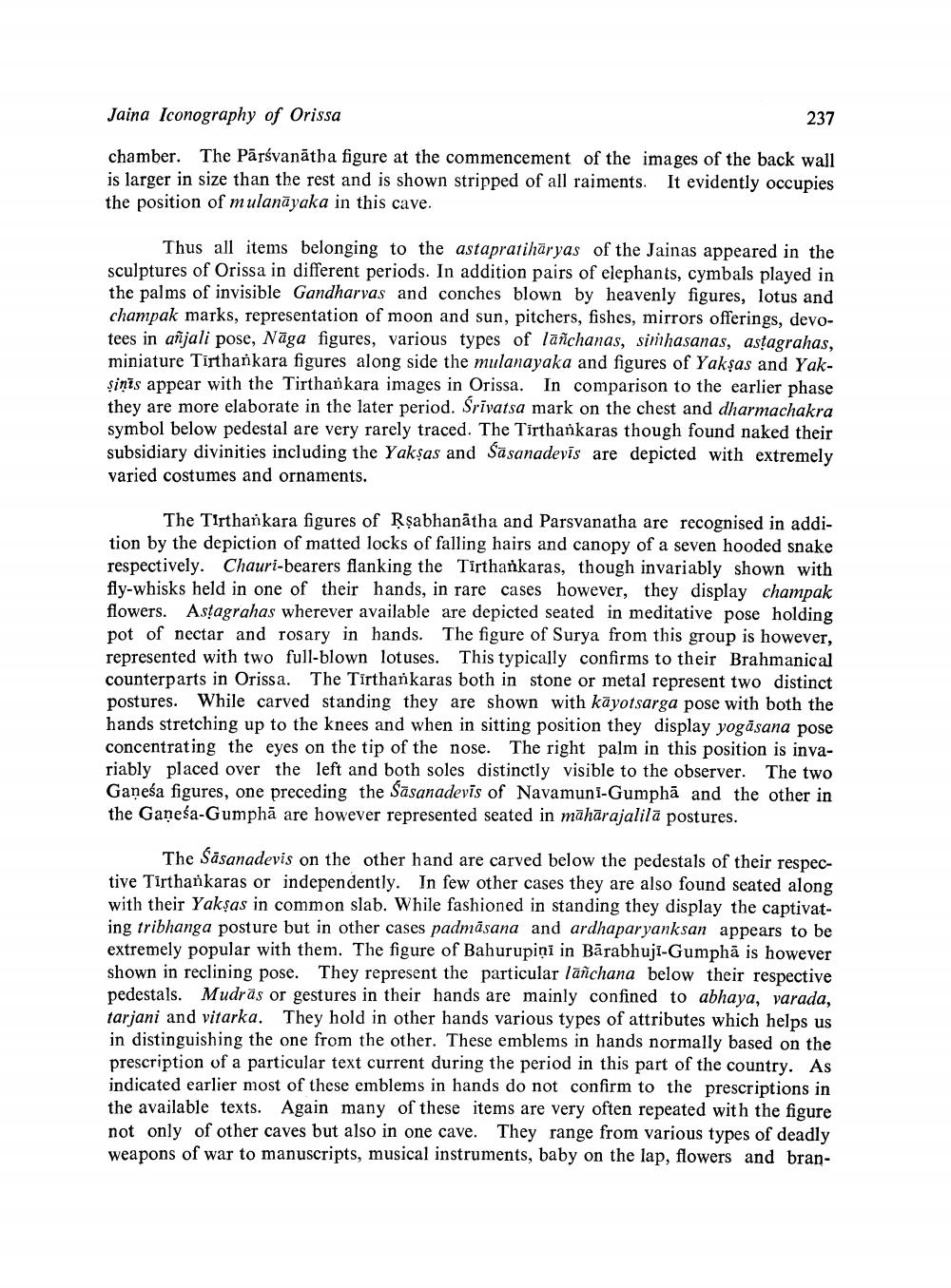________________
Jaina Iconography of Orissa
237
chamber. The Pārsvanātha figure at the commencement of the images of the back wall is larger in size than the rest and is shown stripped of all raiments. It evidently occupies the position of mulanāyaka in this cave.
Thus all items belonging to the astapratihäryas of the Jainas appeared in the sculptures of Orissa in different periods. In addition pairs of elephants, cymbals played in the palms of invisible Gandharvas and conches blown by heavenly figures, lotus and champak marks, representation of moon and sun, pitchers, fishes, mirrors offerings, devotees in añjali pose, Nāga figures, various types of lanchanas, simhasanas, astagrahas, miniature Tirtharkara figures along side the mulanayaka and figures of Yakşas and Yakșinis appear with the Tirthankara images in Orissa. In comparison to the earlier phase they are more elaborate in the later period. Srivatsa mark on the chest and dharmachakra symbol below pedestal are very rarely traced. The Tirthankaras though found naked their subsidiary divinities including the Yakşas and Sasanadevīs are depicted with extremely varied costumes and ornaments.
The Tirthankara figures of Rşabhanātha and Parsvanatha are recognised in addition by the depiction of matted locks of falling hairs and canopy of a seven hooded snake respectively. Chauri-bearers flanking the Tirthankaras, though invariably shown with fly-whisks held in one of their hands, in rare cases however, they display champak flowers. Astagrahas wherever available are depicted seated in meditative pose holding pot of nectar and rosary in hands. The figure of Surya from this group is however, represented with two full-blown lotuses. This typically confirms to their Brahmanical counterparts in Orissa. The Tirthankaras both in stone or metal represent two distinct postures. While carved standing they are shown with kāyotsarga pose with both the hands stretching up to the knees and when in sitting position they display yogasana pose concentrating the eyes on the tip of the nose. The right palm in this position is invariably placed over the left and both soles distinctly visible to the observer. The two Ganesa figures, one preceding the Sasanadevis of Navamuni-Gumphā and the other in the Ganesa-Gumphā are however represented seated in māhārajalilā postures.
The Sāsanadevis on the other hand are carved below the pedestals of their respective Tirthankaras or independently. In few other cases they are also found seated along with their Yakşas in common slab. While fashioned in standing they display the captivating tribhanga posture but in other cases padmāsana and ardhaparyanksan appears to be extremely popular with them. The figure of Bahurupiņi in Bārabhuji-Gumphā is however shown in reclining pose. They represent the particular lañchana below their respective pedestals. Mudräs or gestures in their hands are mainly confined to abhaya, varada, tarjani and vitarka. They hold in other hands various types of attributes which helps us in distinguishing the one from the other. These emblems in hands normally based on the prescription of a particular text current during the period in this part of the country. As indicated earlier most of these emblems in hands do not confirm to the prescriptions in the available texts. Again many of these items are very often repeated with the figure not only of other caves but also in one cave. They range from various types of deadly weapons of war to manuscripts, musical instruments, baby on the lap, flowers and bran




